
Cabinet making
Encyclopedia

Woodworking
Woodworking is the process of building, making or carving something using wood.-History:Along with stone, mud, and animal parts, wood was one of the first materials worked by early humans. Microwear analysis of the Mousterian stone tools used by the Neanderthals show that many were used to work wood...
skills to create cabinets, shelving and furniture
Furniture
Furniture is the mass noun for the movable objects intended to support various human activities such as seating and sleeping in beds, to hold objects at a convenient height for work using horizontal surfaces above the ground, or to store things...
.
Cabinet making involves techniques such as creating appropriate joints
Woodworking joints
Joinery is a part of woodworking that involves joining together pieces of wood, to create furniture, structures, toys, and other items. Some wood joints employ fasteners, bindings, or adhesives, while others use only wood elements. The characteristics of wooden joints - strength, flexibility,...
, dados
Dado (joinery)
A dado , housing or trench is a slot or trench cut into the surface of a piece of machinable material, usually wood. When viewed in cross-section, a dado has three sides...
, bevel
Bevel
A beveled edge refers to an edge of a structure that is not perpendicular to the faces of the piece. The words bevel and chamfer overlap in usage; in general usage they are often interchanged, while in technical usage they may sometimes be differentiated as shown in the image at right.-Cutting...
s, chamfer
Chamfer
A chamfer is a beveled edge connecting two surfaces. If the surfaces are at right angles, the chamfer will typically be symmetrical at 45 degrees. A fillet is the rounding off of an interior corner. A rounding of an exterior corner is called a "round" or a "radius"."Chamfer" is a term commonly...
s and shelving systems, the use of finishing tools such as router
Wood router
A router is a tool used to rout out an area in the face of a relatively hard workpiece, typically of wood or plastic. The main application of routers is in woodworking, especially cabinetry....
s to create decorative edgings, and so on.
History
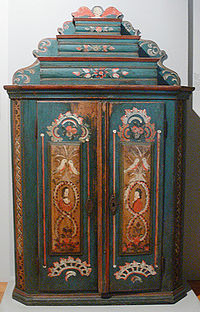
Industrial design
Industrial design is the use of a combination of applied art and applied science to improve the aesthetics, ergonomics, and usability of a product, but it may also be used to improve the product's marketability and production...
, cabinet makers were responsible for the conception and the production of any piece of furniture. In the last half of the 18th century, cabinet makers such as Thomas Sheraton
Thomas Sheraton
Thomas Sheraton was a furniture designer, one of the "big three" English furniture makers of the 18th century, along with Thomas Chippendale and George Hepplewhite.-Biography:...
, Thomas Chippendale
Thomas Chippendale
Thomas Chippendale was a London cabinet-maker and furniture designer in the mid-Georgian, English Rococo, and Neoclassical styles. In 1754 he published a book of his designs, titled The Gentleman and Cabinet Maker's Director...
and George Hepplewhite
George Hepplewhite
George Hepplewhite was a cabinetmaker. He is regarded as having been one of the "big three" English furniture makers of the 18th century, along with Thomas Sheraton and Thomas Chippendale...
also published books of furniture forms. These books were compendiums of their designs and those of other cabinet makers.
With the industrial revolution
Industrial Revolution
The Industrial Revolution was a period from the 18th to the 19th century where major changes in agriculture, manufacturing, mining, transportation, and technology had a profound effect on the social, economic and cultural conditions of the times...
and the application of steam
Watt steam engine
The Watt steam engine was the first type of steam engine to make use of steam at a pressure just above atmospheric to drive the piston helped by a partial vacuum...
power to cabinet making tools, mass production
Mass production
Mass production is the production of large amounts of standardized products, including and especially on assembly lines...
techniques were gradually applied to nearly all aspects of cabinet making, and the traditional cabinet shop ceased to be the main source of furniture, domestic or commercial. In parallel to this evolution there came a growing demand by the rising middle class
Middle class
The middle class is any class of people in the middle of a societal hierarchy. In Weberian socio-economic terms, the middle class is the broad group of people in contemporary society who fall socio-economically between the working class and upper class....
in most industrialised countries for finely made furniture. This eventually resulted in a growth in the total number of traditional cabinet makers.
Before 1650, fine furniture was a rarity in Western Europe and North America. Generally, people did not need it and for the most part could not afford it. They made do with simple but serviceable pieces.
The arts and craft movement which started in the United Kingdom
United Kingdom
The United Kingdom of Great Britain and Northern IrelandIn the United Kingdom and Dependencies, other languages have been officially recognised as legitimate autochthonous languages under the European Charter for Regional or Minority Languages...
in the middle of the 19th century spurred a market for traditional cabinet making, and other craft
Craft
A craft is a branch of a profession that requires some particular kind of skilled work. In historical sense, particularly as pertinent to the Medieval history and earlier, the term is usually applied towards people occupied in small-scale production of goods.-Development from the past until...
goods. It rapidly spread to the United States
United States
The United States of America is a federal constitutional republic comprising fifty states and a federal district...
and to all the countries in the British Empire
British Empire
The British Empire comprised the dominions, colonies, protectorates, mandates and other territories ruled or administered by the United Kingdom. It originated with the overseas colonies and trading posts established by England in the late 16th and early 17th centuries. At its height, it was the...
. This movement exemplified the reaction to the eclectic historicism of the Victorian era
Victorian era
The Victorian era of British history was the period of Queen Victoria's reign from 20 June 1837 until her death on 22 January 1901. It was a long period of peace, prosperity, refined sensibilities and national self-confidence...
and to the 'soulless' machine-made production which was starting to become widespread.
After World War II
World War II
World War II, or the Second World War , was a global conflict lasting from 1939 to 1945, involving most of the world's nations—including all of the great powers—eventually forming two opposing military alliances: the Allies and the Axis...
woodworking became a popular hobby
Hobby
A hobby is a regular activity or interest that is undertaken for pleasure, typically done during one's leisure time.- Etymology :A hobby horse is a wooden or wickerwork toy made to be ridden just like a real horse...
among the middle classes. The more serious and skilled amateurs in this field now turn out pieces of furniture which rival the work of professional cabinet makers. Together, their work now represents but a small percentage of furniture production in any industrial country, but their numbers are vastly greater than those of their counterparts in the 18th century and before.
Schools of design
ScandinavianThis style of design is typified by clean horizontal and vertical lines. Compared to other designs there is a distinct absence of ornamentation. While Scandinavian design
Scandinavian Design
Scandinavian design emerged in the 1950s in the three Scandinavian countries , as well as Finland. It is a design movement characterized by simple designs, minimalism, functionality, and low-cost mass production....
is easy to identify, it is much more about the materials than the design.
French Provincial
This style of design is very ornate. French Provincial
French furniture
French furniture comprises both the most sophisticated furniture made in Paris for king and court, aristocrats and rich upper bourgeoisie, on the one hand, and French provincial furniture made in the provincial cities and towns many of which, like Lyon and Liège, retained cultural identities...
objects are often stained or painted leaving the wood concealed. Corners and bevels are often painted with a gold leave or given some other kind of gilding. Flat surfaces often have artwork such as landscapes painted directly on them. The wood used in provincial varied, but was often originally Beech.
Early American Colonial
This design emphasises both form and materials. Early American chairs and tables are often constructed with turned spindles and chair backs often constructed with steaming to bend the wood. Wood choices tend to be deciduous hardwoods with a particular emphasis on the wood of edible or fruit bearing trees such as Cherry or Walnut.
Rustic
The rustic
Rustic furniture
Rustic furniture is furniture employing sticks, twigs or logs for a natural look. Many companies, artists and craftspeople make rustic furniture in a variety of styles and with a variety of historical and contemporary influences...
style of design sometimes called "log furniture" or "log cabin
Log cabin
A log cabin is a house built from logs. It is a fairly simple type of log house. A distinction should be drawn between the traditional meanings of "log cabin" and "log house." Historically most "Log cabins" were a simple one- or 1½-story structures, somewhat impermanent, and less finished or less...
" is the least finished. Design is very utilitarian yet seeks to feature not only the materials used but in as much as possible, how they existed in their natural state. For example a table top may have what is considered a "live edge" that allows you to see the original contours of the tree that it came from. It also often uses whole logs or branches including the bark of the tree. Rustic furniture is often made from Pine
Pine
Pines are trees in the genus Pinus ,in the family Pinaceae. They make up the monotypic subfamily Pinoideae. There are about 115 species of pine, although different authorities accept between 105 and 125 species.-Etymology:...
, Cedar, Fir
Fir
Firs are a genus of 48–55 species of evergreen conifers in the family Pinaceae. They are found through much of North and Central America, Europe, Asia, and North Africa, occurring in mountains over most of the range...
and Spruce
Spruce
A spruce is a tree of the genus Picea , a genus of about 35 species of coniferous evergreen trees in the Family Pinaceae, found in the northern temperate and boreal regions of the earth. Spruces are large trees, from tall when mature, and can be distinguished by their whorled branches and conical...
. Also see Adirondack Architecture
Adirondack Architecture
Adirondack Architecture refers to the rugged architectural style generally associated with the Great Camps within the Adirondack Mountains area in New York. The builders of these camps used native building materials and sited their buildings within an irregular wooded landscape...
.
Mission Style
Mission Design
Mission Style Furniture
Mission furniture is a style of furniture that originated in the late 19th Century. It traces its origins to a chair made by A.J. Forbes around 1894 for San Francisco's Swedenborgian Church. The term mission furniture was first popularized by Joseph P...
is characterized by straight, thick horizontal and vertical lines and flat panels. The most common material used in Mission furniture is oak. For early mission cabinetmakers, the material of choice was white oak, which they often darkened through a process known as "fuming". Hardware is often visible on the outside of the pieces and made of black iron. It is a style that became popular in the early 20th century; popularized by designers in the Arts and Crafts and Art Nouveaux movements.
Oriental
Also known as Asian Design
Asian furniture
The term Asian furniture or sometimes referred to Oriental furniture is a type of furniture that originated from the continent of Asia. Sometimes people also think of Asian furniture as a style of furniture that has Asian accents...
, this style of furniture is characterized by its use of materials such as bamboo
Bamboo
Bamboo is a group of perennial evergreens in the true grass family Poaceae, subfamily Bambusoideae, tribe Bambuseae. Giant bamboos are the largest members of the grass family....
and rattan
Rattan
Rattan is the name for the roughly 600 species of palms in the tribe Calameae, native to tropical regions of Africa, Asia and Australasia.- Structure :...
. Red is a frequent color choice along with landscape art and Chinese or other Asian language characters on the pieces.
Shaker
Shaker furniture
Shaker furniture
Shaker furniture is a distinctive style of furniture developed by the United Society of Believers in Christ's Second Appearing , a religious sect founded by Jane and James Wardley. They came to America from Manchester, England in 1774 led by Mother Ann Lee. Shaker furniture is widely admired for...
design is focused on function and symmetry. Because it is so influenced by an egalitarian religious community and tradition it is rooted in the needs of the community versus the creative expression of the designer. Like Early American and Colonial design, Shaker craftsmen often chose fruit woods for their designs. Pieces reflect a very efficient use of materials.
Types of cabinetry

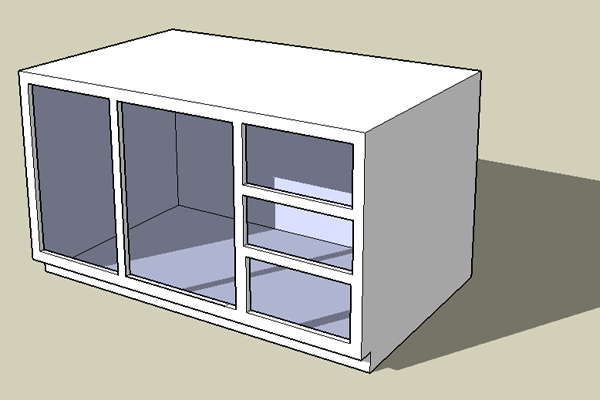
A cabinet may be built-in or free-standing. A built-in cabinet is usually custom made for a particular situation and it is fixed into position, on a floor, against a wall, or framed in an opening. For example modern kitchens are examples of built-in cabinetry. Free-standing cabinets are more commonly available as off-the-shelf items and can be moved from place to place if required. Cabinets may be wall hung or suspended from the ceiling.
Cabinets may have a face frame
Face frame
A face frame in cabinet making is the frame fixed to the front of a cabinet carcass which obscures the edges of the carcass and provides the fixing point for doors and other external hardware...
or may be of frameless construction
Frameless construction
Frameless construction in cabinetmaking refers to the construction of cabinets using flat panels of engineered wood — usually particle board, plywood or medium-density fibreboard — rather than the traditional frame and panel construction....
(also known as European or euro-style). Face frame cabinets have a supporting frame attached to the front of the cabinet box. This face frame is usually 1½ inches in width. Mounted on the cabinet frame is the cabinet door. In contrast, frameless cabinet have no such supporting front face frame, the cabinet doors attach directly to the sides of the cabinet box. The box’s side, bottom and top panels are usually 5/8 to 3/4 inches thick, with the door overlaying all but 1/16 inch of the box edge.
Modern cabinetry is often frameless and is typically constructed from man-made sheet materials, such as plywood
Plywood
Plywood is a type of manufactured timber made from thin sheets of wood veneer. It is one of the most widely used wood products. It is flexible, inexpensive, workable, re-usable, and can usually be locally manufactured...
, chipboard
Chipboard
Chipboard may refer to:* A type of paperboard generally made from reclaimed paper stock; the term generally used in the US** White lined chipboard, a grade of paperboard* Particle board, a type of engineered wood known as "chipboard" in some countries...
or MDF
Medium-density fibreboard
Medium-density fiberboard is an engineered wood product formed by breaking down hardwood or softwood residuals into wood fibres, often in a defibrator, combining it with wax and a resin binder, and forming panels by applying high temperature and pressure...
. The visible surfaces of these materials are usually clad in a timber veneer
Wood veneer
In woodworking, veneer refers to thin slices of wood, usually thinner than 3 mm , that are typically glued onto core panels to produce flat panels such as doors, tops and panels for cabinets, parquet floors and parts of furniture. They are also used in marquetry...
, plastic laminate, or other material. They may also be painted.
Bases
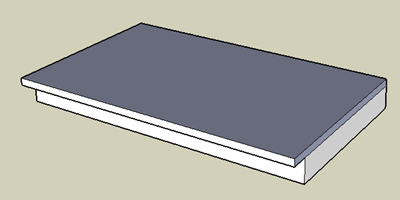
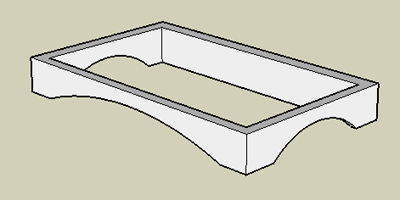
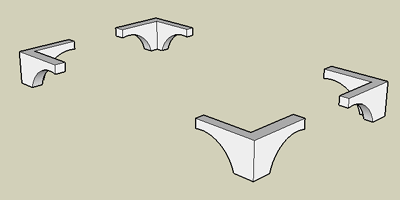
Plinth
In architecture, a plinth is the base or platform upon which a column, pedestal, statue, monument or structure rests. Gottfried Semper's The Four Elements of Architecture posited that the plinth, the hearth, the roof, and the wall make up all of architectural theory. The plinth usually rests...
), a scrolled based, bracket feet or it could be a set of legs.
Adjustable feet
A relatively new type of adjustable leg has been adopted from the European cabinet system which offers several advantages. First off, in making base cabinets for kitchens, the cabinet sides would be cut to 34½ inches, yielding four cabinet side blanks per 4 foot by 8 foot sheet. Using the adjustable feet, the side blanks are cut to 30 inches, thus yielding six cabinet side per sheet.These feet can be secured to the bottom of the cabinet by having the leg base screwed onto the cabinet bottom. They can also be attached by means of a hole drilled through the cabinet bottom at specific locations. The legs are then attached to the cabinet bottom by a slotted, hollow machine screw. The height of the cabinet can be adjusted from inside the cabinet, simply by inserting a screwdriver into the slot and turning to raise or lower the cabinet. The holes in the cabinet are capped by plastic inserts, making the appearance more acceptable for residential cabinets. Using these feet, the cabinets need not be shimmed or scribed to the floor for leveling. The toe kick board is attached to the cabinet by means of a clip, which is either screwed onto the back side of the kick board, or a barbed plastic clip is inserted into a saw kerf, also made on the back side of the kick board. This toe kick board can be made to fit each base cabinet, or made to fit a run of cabinets.
Kitchen cabinets, or any cabinet generally at which a person may stand, usually have a fully enclosed base in which the front edge has been set back 75 mm or so to provide room for toes, known as the kick space. A scrolled base is similar to the fully enclosed base but it has areas of the base material removed, often with a decorative pattern, leaving feet on which the cabinet stands. Bracket feet are separate feet, usually attached in each corner and occasionally for larger pieces in the middle of the cabinet.
Compartments
A cabinet usually has at least one compartment. Compartments may be open, as in open shelving; they may be enclosed by one or more doors; or they may contain one or more drawers. Some cabinets contain secret compartments, access to which is generally not obvious.Modern cabinets employ many more complicated means (relative to a simple shelf) of making browsing lower cabinets more efficient and comfortable. Such means include (names may be heavily colloquialised
Colloquialism
A colloquialism is a word or phrase that is common in everyday, unconstrained conversation rather than in formal speech, academic writing, or paralinguistics. Dictionaries often display colloquial words and phrases with the abbreviation colloq. as an identifier...
):
- The lazy susanLazy SusanA Lazy Susan is a rotating tray, usually circular, placed on top of a table to aid in moving food on a large table or countertop.- Origin :The term "Lazy Susan" made its first written appearance in a Good Housekeeping article in 1906, although their existence dates back to the 18th century...
, a shelf which rotates around a central axis, allowing items stored at the back of the cabinet to be brought to the front by rotating the shelf. These are usually used in corner cabinets, which are larger and deeper and have a greater "dead space" at the back than other cabinets.
Cabinet insert hardware
Another recent development in cabinet inserts or hardware, often taking the place of the lazy susanLazy Susan
A Lazy Susan is a rotating tray, usually circular, placed on top of a table to aid in moving food on a large table or countertop.- Origin :The term "Lazy Susan" made its first written appearance in a Good Housekeeping article in 1906, although their existence dates back to the 18th century...
, particularly in base cabinets is the blind corner cabinet pull out unit. These units pull out and turn, making the attached shelving unit slide into the open area of the cabinet door, thus making the shelves accessible to the user. These units vary greatly in design and cost, but are very practical in making what was once dead space usable.
Other insert hardware is continuously being designed and includes such items as mixer shelves that pull out of a base cabinet and spring into a locked position at counter height. This hardware makes lifting these somewhat heavy mixers and mechanically helping with the process of positioning the unit for use. More and more components are being designed to enable specialized hardware to be used in standard cabinet carcasses.
Tops
Most cabinets incorporate a top of some sort. In many cases, the top is merely to enclose the compartments within and serves no other purpose - as in a wall hung cupboard for example. In other cabinets, the top also serves as a work surface - a kitchen countertop for example.See also
- Cabinet (furniture)Cabinet (furniture)A cabinet is usually a box-shaped piece of furniture with doors or drawers for storing miscellaneous items. Some cabinets stand alone while others are built into a wall or are attached to it like a medicine cabinet. Cabinets are typically made of wood or, now increasingly, of synthetic...
- ÉbénisteÉbénisteÉbéniste is the French word for a cabinetmaker, whereas in French menuisier denotes a woodcarver or chairmaker. The English equivalent for "ébéniste," "ebonist," is never commonly used. Originally, an ébéniste was one who worked with ebony, a favoured luxury wood for mid-seventeenth century...
- List of furniture designers
- WoodworkingWoodworkingWoodworking is the process of building, making or carving something using wood.-History:Along with stone, mud, and animal parts, wood was one of the first materials worked by early humans. Microwear analysis of the Mousterian stone tools used by the Neanderthals show that many were used to work wood...
- List of furniture types
- AmishAmishThe Amish , sometimes referred to as Amish Mennonites, are a group of Christian church fellowships that form a subgroup of the Mennonite churches...
External links
- Cabinet Making Tips Pro Woodworking Tips.com
- Radiator Cabinets Radiator Cabinets Makers
- Furniture & Cabinetmaking Magazine
- Base Cabinet Construction Pro Woodworking Tips.com
- Custom vs. Factory Cabinets Video
- Short History of Cabinets
- Cabinet Makers Association
- the Institute of Carpenters
- Woodworking Basics

